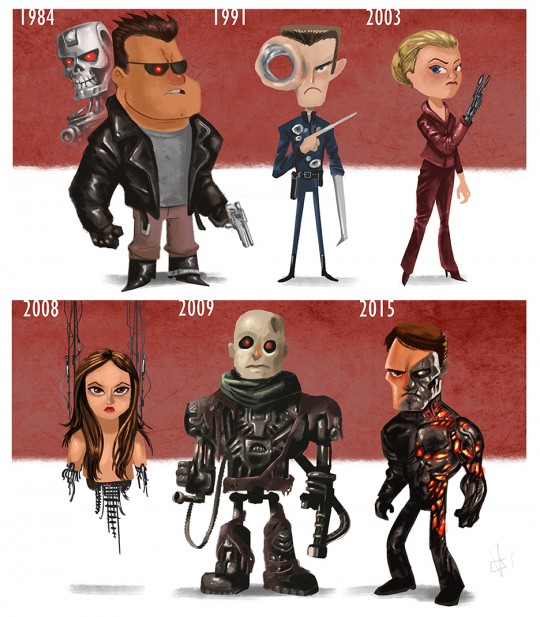The arc of the moral universe is long, but it bends towards Skynet.
That’s my takeaway from five Terminator movies. No matter what we do, no matter how many attempts we make to go through time to stop it, we’re going to wind up with a self-aware computer system that is bent on the destruction of mankind.
After a brief reintroduction to the series—we see the nukes launch while a voiceover from Kyle Reese (Jai Courtney) explains how the machines became self-aware and launched Judgment Day in 1997—Terminator Genisys opens in a post-apocalyptic future. John Connor (Jason Clarke) and Reese are on a mission to smash Skynet. It’s the last battle of the war, he says, and audiences familiar with the series will realize where, and when, we are: at the site of the time-displacement device moments before Kyle is sent back in time to save Sarah Connor (Emilia Clarke).
As Reese steps into the device, something goes wrong. John is assaulted by one of the soldiers in the room, an event that disrupts the time stream and causes Reese to create new memories, "impossible memories," as he puts it.
And then we’re in Los Angeles. It’s 1984. There’s a familiar nude Model 101 Series 800 demanding clothes from a group of punks. But nothing else is as we remember: This newcomer is confronted by an older, aged version of the same machine (Arnold Schwarzenegger) who is fighting alongside Sarah Connor and whom Sarah affectionately refers to as "Pop" because he raised her after saving her from a Terminator that murdered her folks in 1973. Kyle Reese has landed outside a clothing store and stolen the pants off of a bum. But he’s met by a T-1000.
I won’t get into the various ins and outs and sideways discursions of the plot, in part because I don’t want to spoil them. But also because I don’t fully understand them. In part this is because the script is rather haphazardly put together (we never discover who sent the older T-800 back in time to protect Sarah, for instance).
It’s also because Terminator: Genisys serves as an explicit repudiation of the original film’s thesis: that Reese needs to save Sarah in order to ensure that the robots of the future can’t erase humanity’s triumph. At one point, John Connor (who, long story short, has traveled through time himself) tells Sarah and Kyle that they all exist out of time, that nothing they do can impact the future. If John kills either Sarah or Kyle—his parents—he will not blink out of existence.
This thesis is reinforced by the way the film is constructed. The opening moments ignore the events of Terminator 3: Rise of the Machines and Terminator Salvation, placing Judgment Day at the original film’s date of August 27, 1997. Which means that the destruction of Cyberdyne in Terminator 2: Judgment Day didn’t alter the future so much as create a new timeline (explored in Rise of the Machines and Salvation) that plays no role here.
The larger point is a simple one: When you’re playing around with something like time travel, as a storytelling concept, it’s easy to lose any sense of stakes. How can you ever "win" when your opponent can simply travel back and forth through time to thwart you? How can you ever "lose" when you can simply travel back and forth through time to save the day? It’s simply too powerful a narrative tool to use to build a film series out of.
This confusion was handled elegantly in the first film by director and cowriter James Cameron. "Are you saying it’s from the future?" Sarah asked Reese in the original. "One possible future, from your point of view," Reese sighs in response. "I don’t know tech stuff." That’s because "tech stuff" didn’t really matter in The Terminator: It was a movie about a man completing a mission. We didn’t get into the higgledy-piggledy of time paradoxes until its sequel.
Is Terminator: Genisys any fun? I liked it more than I thought I would, though I’m still not entirely sure I, you know, liked liked it. The action sequences are relatively well constructed and more coherent than is all-too-often the case in Hollywood fare. It’s nice to have Arnold back in the saddle, and the robot’s dry sense of "humor" wears well on the aging star. Clarke can’t replace Linda Hamilton—she seems small and soft compared to the hard-edged Sarah Connor from Judgment Day. Nor do I understand why Hollywood is still trying to make Jai Courtney a thing.
Do not under any circumstances see this movie in 3D. The screening I was at was blurry and out of focus, creating a headache-inducing double-vision effect. Though it’s impossible to say whether or not this was a mistake on the part of the Regal Majestic in Silver Spring, Md., or the filmmakers themselves—who used the vastly inferior conversion process in order to squeeze a few extra bucks out of you—I wouldn’t risk it.
